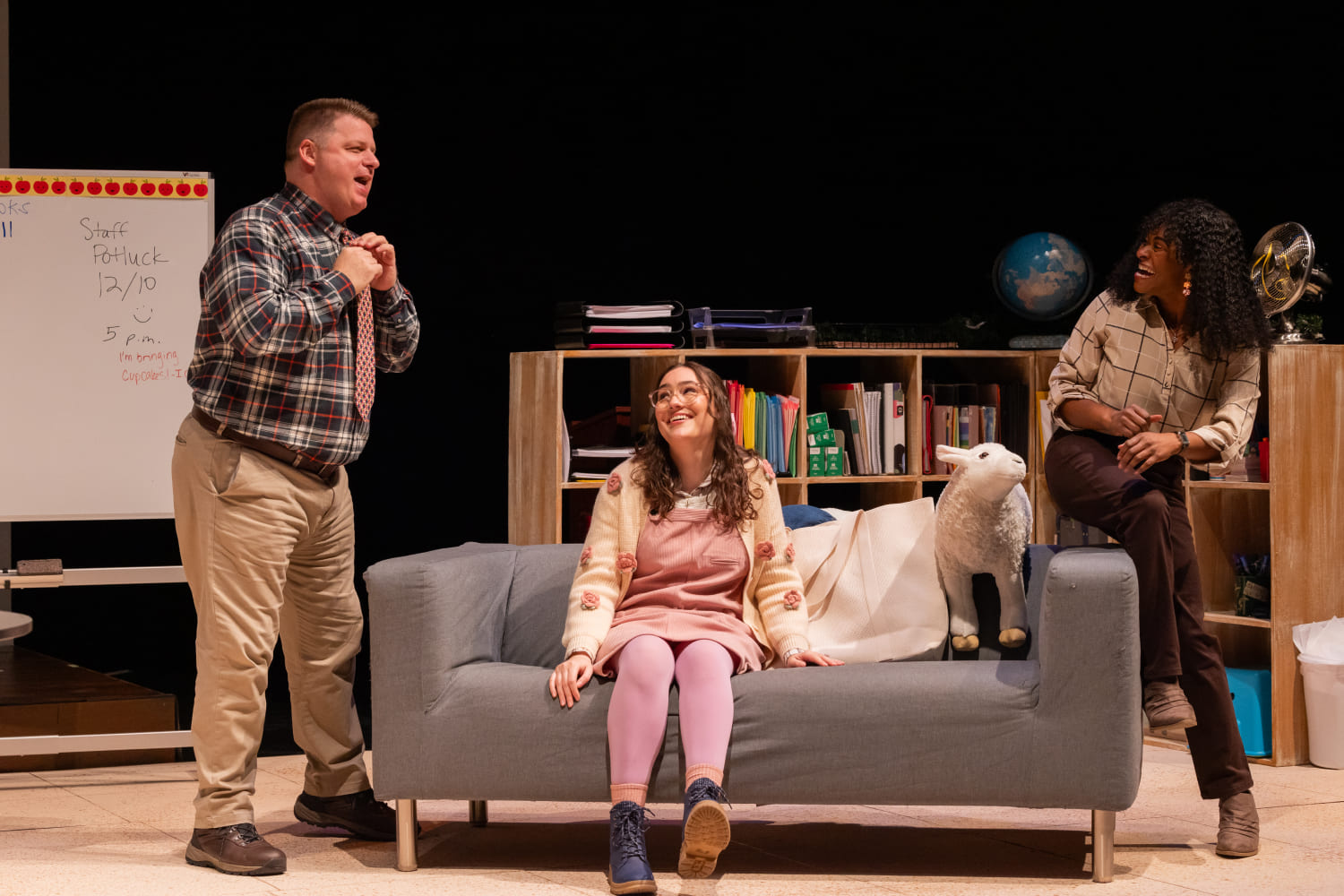
Jeff Burleson, Kimmie Harvey and Rita Cole in City Theatre's "Black Santa." (Photo by Morgan Sophia Photography)
The tense, well-meaning white woman in Aaron Mays' satirical comedy “Black Santa” gasps. Shock registers on her face, and then in her voice as she incredulously asks: “Are you calling me the 'R' word? I donate to the AIDS fund for African refugees every year! And I listen to NPR!”
Oh, and in at least one instance, she prefers the term “African American” instead of “Black;” the former is more “politically correct.”
If you are nodding and chuckling, then Mays has you where he wants you. The talented Chicago-based playwright is trying to drive home a serious message in “Black Santa.” However, he does so by making you laugh instead of lecturing or trying to frighten. Indeed, through comedy, artists can sometimes more easily reach audiences with painful subject matter. That is the case in Mays' funny and stimulating play “Black Santa.” It is running in the intimate Carnival Studio Theater at Miami's Adrienne Arsht Center through Sunday, Dec. 22 in a mostly strong Southeast premiere co-production between Miami's City Theatre and the Arsht.
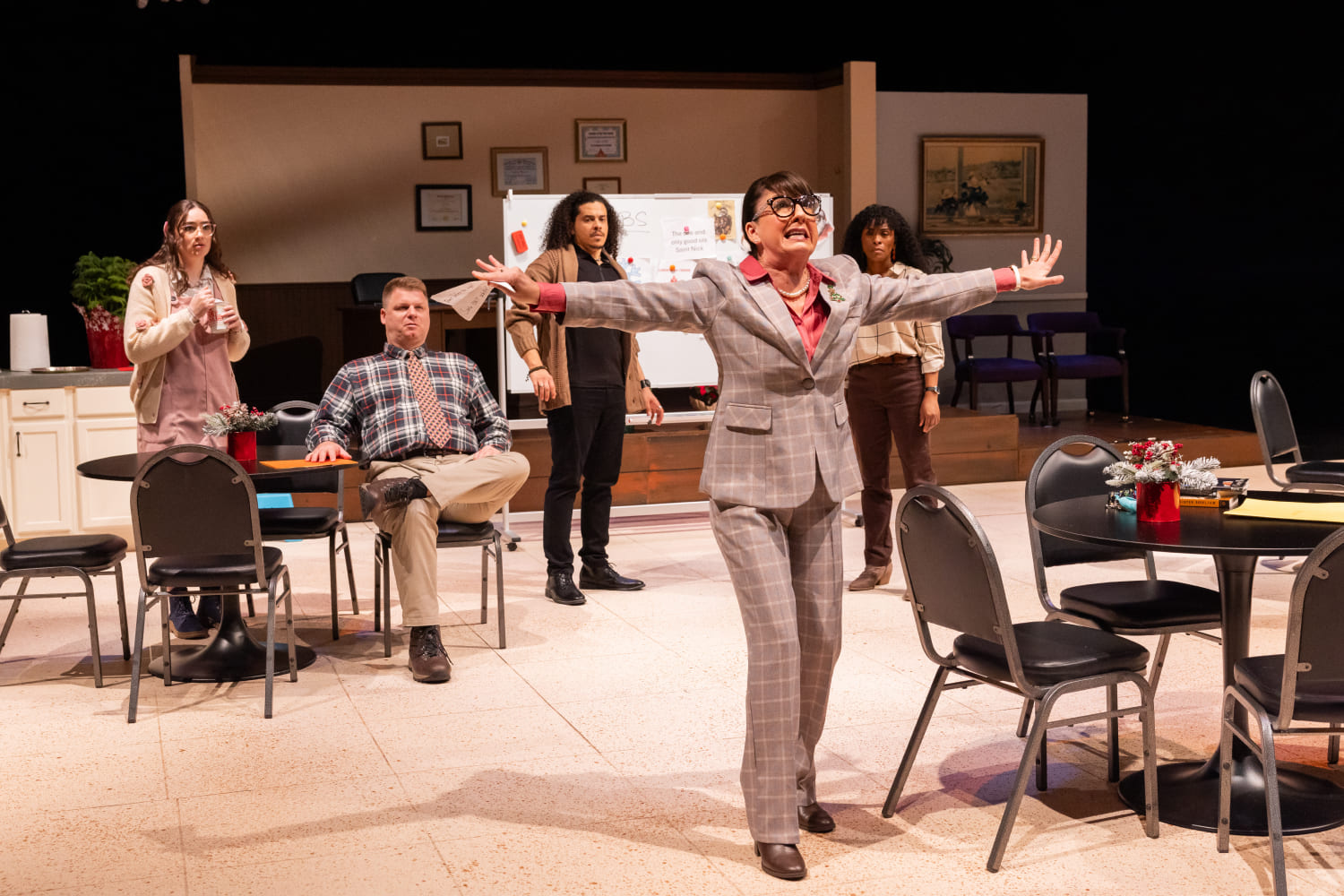
Kimmie Harvey, Jeff Burleson, Phillip Andrew Santiago, Niki Fridh and Rita Cole in City Theatre's BLACK SANTA - Photo by Morgan Sophia Photography
The roughly 98-minute, intermission-less mounting stars local talented performers Rita Cole, Niki Fridh, Phillip Andrew Santiago, Jeff Burleson, Kimmie Harvey, and Robert L. Strain.
Under City Theatre Artistic Director Margaret Ledford's assured direction, the production's six-person cast finds the humor in this timely play without trivializing its characters or topical subject.
The performers are portraying recognizable and relatable characters dealing with a topic that seems benign enough – Santa Claus. Still, as this play proves, “race” is a four-letter word that can stick its nose even in seemingly peaceful situations that you would think are off-limits to such discomfiting matters.
“Black Santa” takes place in Buffalo, N.Y. in 2009, a year after Americans elected Barack Obama as the nation's 44th president. In the piece, Patrice Patterson (Cole) is the only Black teacher at Buffalo's Dartmouth Day School. Previously, she climbed her way to near the top of an agency outside the education field, but could not quite reach the peak. Besides, she wanted to escape the “corporate dog-eat-dog, all-or-nothing” mentality of Corporate America. And teaching “seemed like a safe choice.”
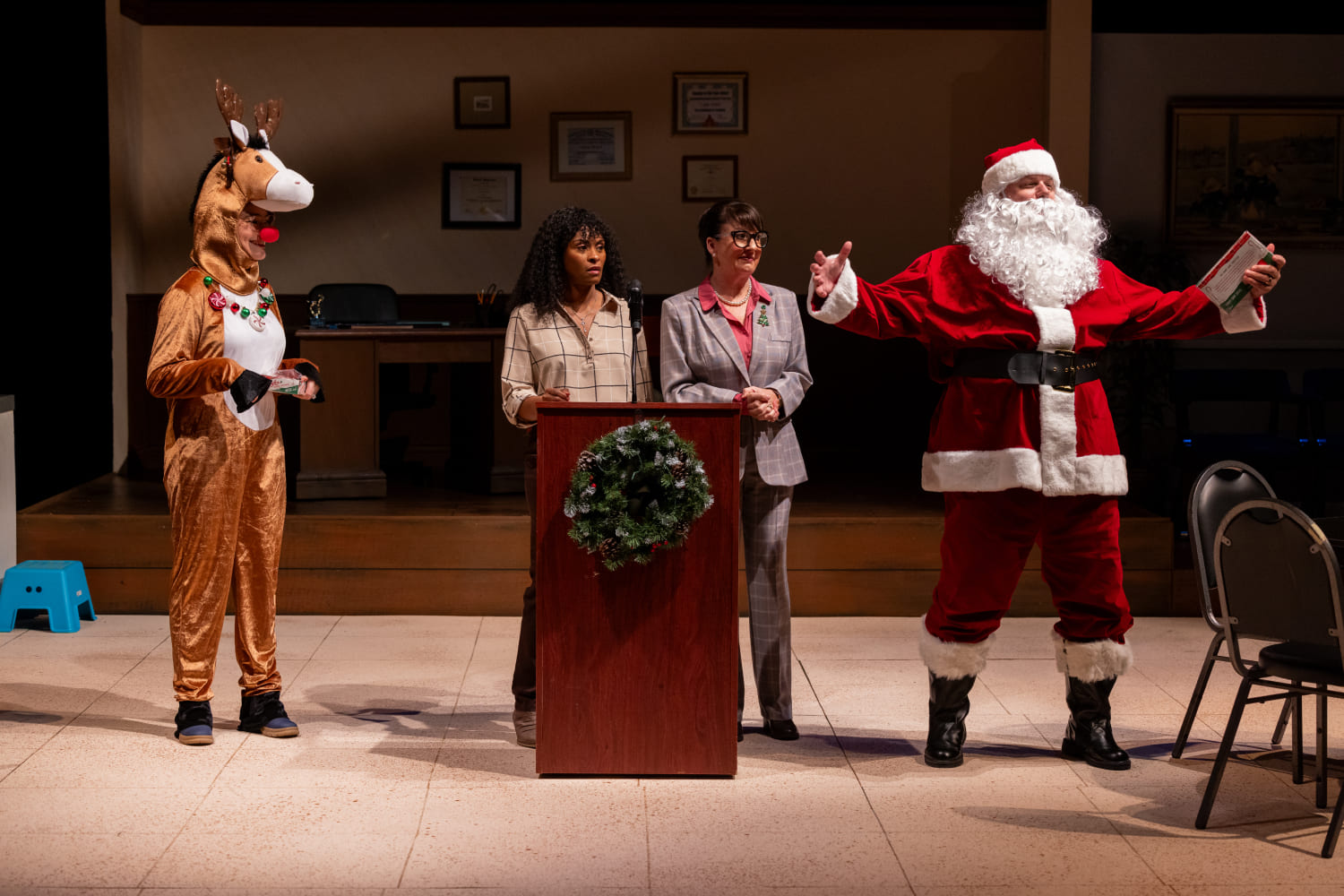
Kimmie Harvey, Rita Cole, Niki Fridh and Jeff Burleson in "Black Santa." (Photo by Morgan Sophia Photography)
When “Black Santa” opens, the students are almost out of school for the holidays. Patterson is enthusiastically reading “Twas the Night Before Christmas” to her third-grade class. All is calm, or at least it seems so.
After reading them the story, Patterson asks the class, “What's one thing you want people to know for this holiday season?” But we do not immediately learn what they say. Instead, Mays adds a bit of mystery to the proceedings by jumping to early morning the next day. Later in the play, we will wonder what exactly transpired in the scene that happens offstage.
The day after Patterson poses her question to students, a group of teachers has arrived at school earlier than usual. Principal Sylvia Ward (Fridh), the aforementioned well-meaning white woman, has called an urgent meeting. Why? One of Patterson's students, a Black girl named Sharifa, supposedly responded to her teacher's question in the previous scene by proclaiming “I want the world to know that Santa Claus is a black man...from Detroit.”
Somehow, this proclamation has upset the equilibrium among the student body. “From what I heard, it took about 30 minutes to stop the crying and screaming,” Ward says. Then, she asks Patterson, “And didn't your teacher aide faint?”
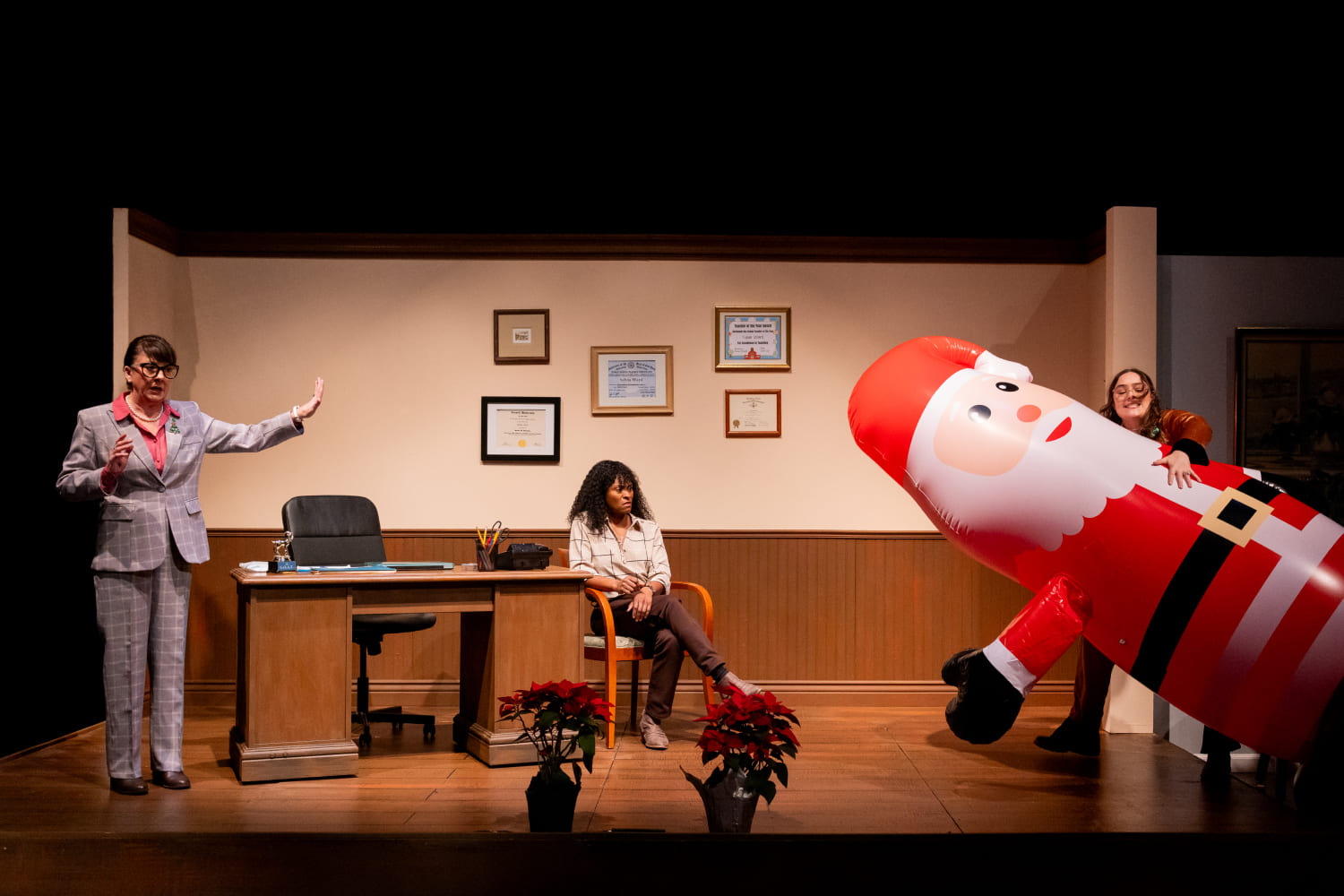
Niki Fridh, Rita Cole and Kimmie Harvey in City Theatre's production of "Black Santa." (Photo by Morgan Sophia Photography)
Patterson responds: "I think all the commotion made her weary and exasperated."
For damage control, the principal puts Patterson and other teachers to work as a committee to come up with a campaign to make Santa white again. And the principal appoints Patterson to head the group. But things get worse. A “manifesto” referring to Santa as a Black man circulates through social media and attracts the attention of local television stations. Is a lockdown necessary, the principal wonders?
While Ward and Co. try to deal with the situation, Patterson has a separate goal she is trying to achieve. For some time at the school, an assistant principal position has remained vacant, and Patterson has long wanted to assume that post. But for some reason, school officials have hesitated to hire anyone. And now, the focus is on Santa's skin color. Patterson believes that it's all much ado about nothing (she dubs the Black Santa situation “Project B.S.”).
Even with Project Black Santa the focus of the moment, the persistent teacher hopes to persuade Ward and the board to hire her as the school's new assistant principal. But first, she'll have to find a way to make Santa white again.
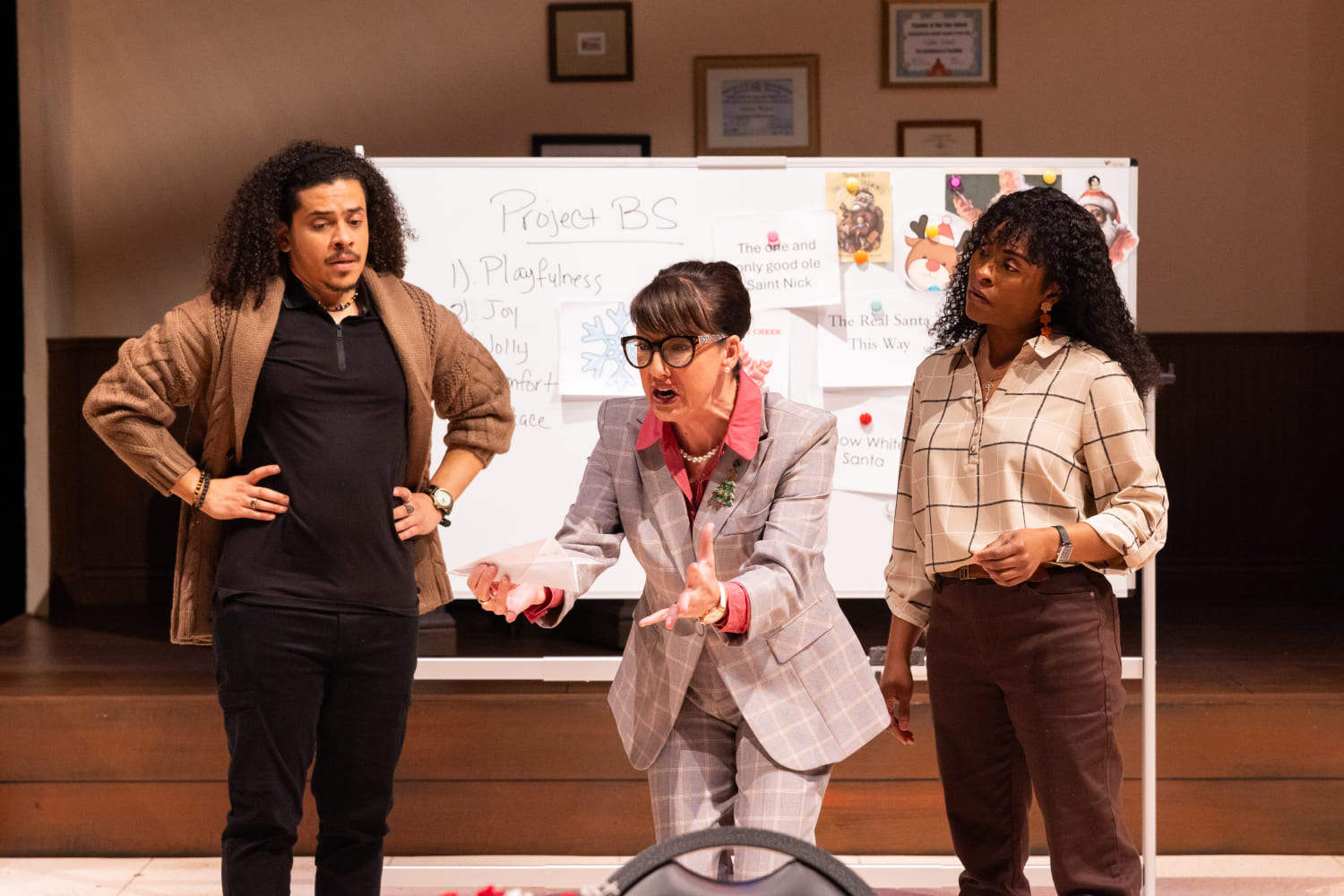
Phillip Andrew Santiago, Niki Fridh and Rita Cole in City Theatre's "Black Santa," a southeastern U.S. premiere by Aaron Mays. (Photo by Morgan Sophia Photography)
“Black Santa” is clearly a comedy, and the action becomes farcical toward the end. Still, Mays obviously has serious matters in mind. For instance, can a post-racial America ever become a reality? The playwright makes you stop and wonder whether that can ever happen, particularly with the hope and optimism that followed Obama's election. In addition, Mays deals with themes such as perseverance, the American ideal of pluralism, and the sacrifices older generations have made for their descendants. The playwright deals with the latter theme, and others, through a touching depiction of the relationship between Patterson and her father, Johnnie Lee (Strain). Cole and Strain, who share a strong chemistry, make the father and daughter relationship truly moving.
“Black Santa” also makes us reflect on how much progress society has made toward solving America's race issue…and how far we have to go. Mays reminds us about such topics through exchanges such as the following:
Patterson: "Have you heard of the Double-O-Seven rule?"
Gabriel (a colleague portrayed by Santiago): "The Double-O-Seven rule? I've never heard of it."
Patterson: "O and O, Oprah and Obama, have cleared the way for all Black people, setting an equal playing field. Why talk about struggle when you have Oprah on TV and Obama in the White House? We're free, we have our rights and we have cable. First-world perks in all its glory."
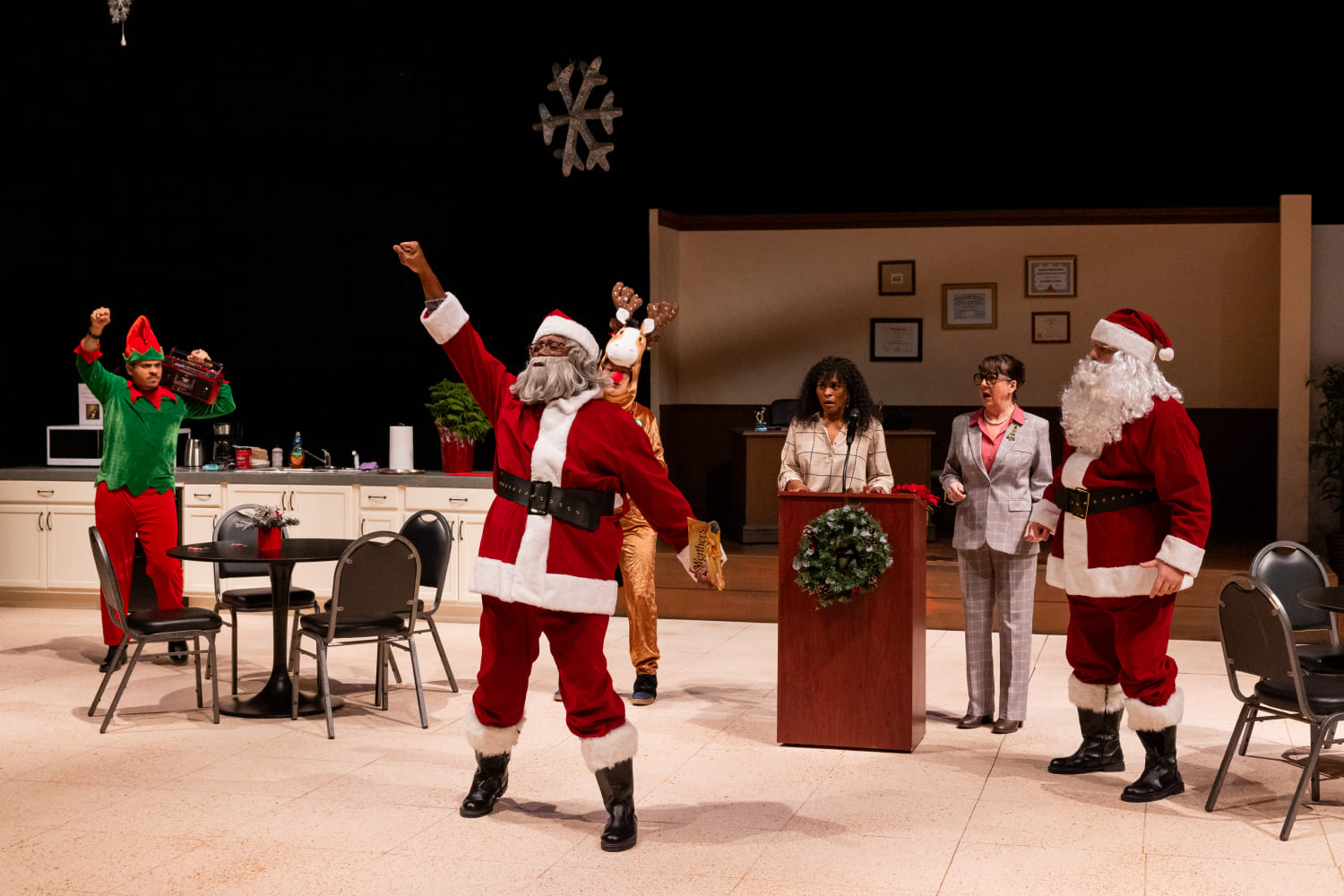
Phillip Andrew Santiago, Robert L. Strain, Kimmie Harvey, Rita Cole, Niki Fridh and Jeff Burleson in City Theatre's "Black Santa." (Photo by Morgan Sophia Photography)
Gabriel: "And the number seven?"
Patterson: "Michael Vick. The infamous number 7. The brother you hate to see on the news. The bronze one who has fallen from grace. The inglorious bastard. The abominable Negro. Yeah, Double-O Seven. For every two steps we take, we take seven steps back."
Gabriel: "And I'm assuming this doesn't apply to other people?"
Patterson: "When your people go through 400-plus years of kidnapping, severe physical labor, subhuman treatment, rape, family separation, lynching, poverty and a myriad of broken promises from the government on all levels, then it can apply."
By the way, Vick, a former NFL quarterback, wore No. 7. He pleaded guilty in 2007 to being involved in a dog fighting ring and served 21 months in federal prison.
If Vick took us seven steps back, as you experience “Black Santa,” you cannot help but wonder how many steps back America took on Nov. 5. In addition, you may also find yourself yearning for the Obama years.
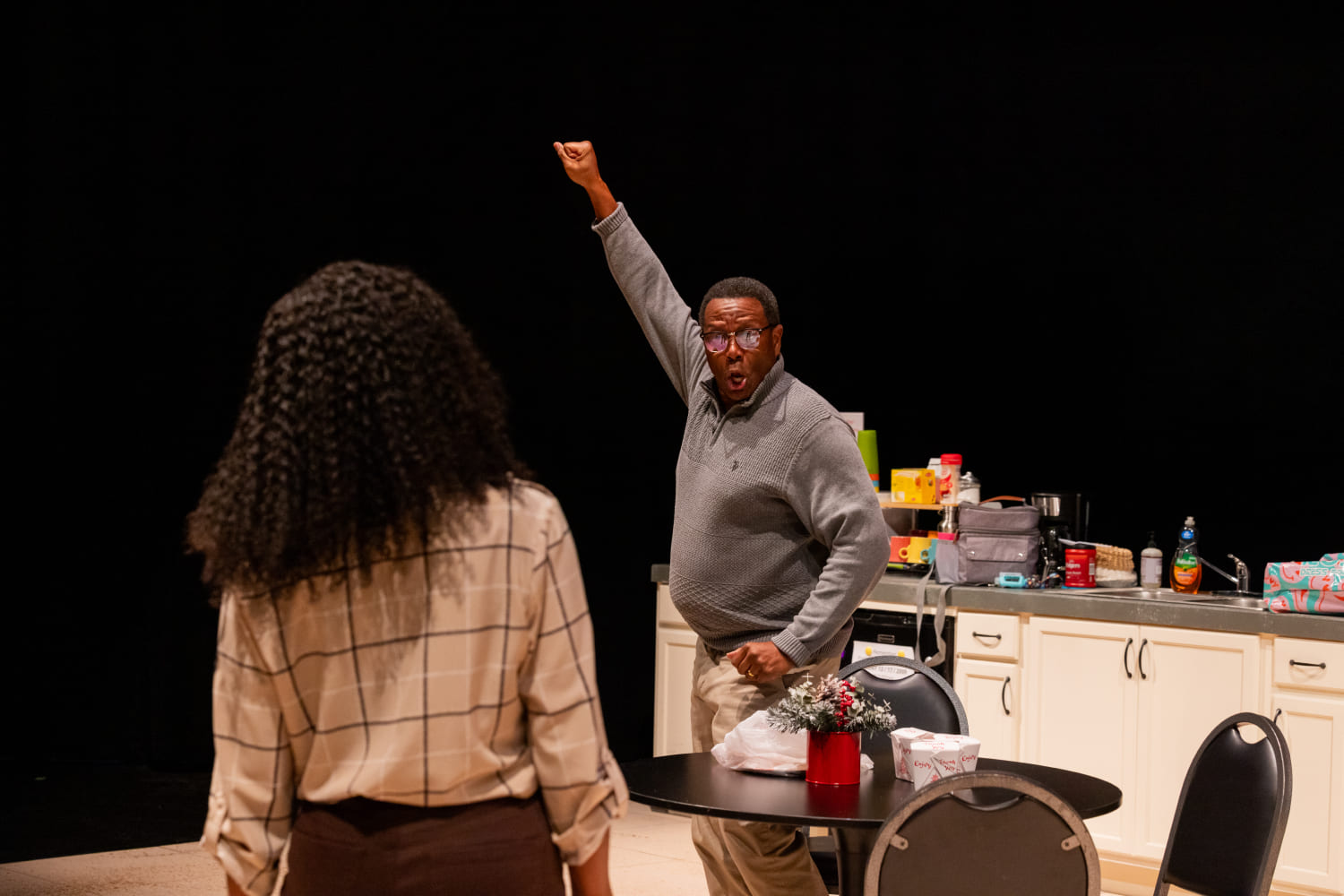
Rita Cole and Robert L. Strain in City Theatre's BLACK SANTA - Photo by Morgan Sophia Photography
While “Black Santa” does not hammer its audience with political messages, it certainly suggests that as a country we have our work cut out for us in a number of areas, including racial matters.
The production does a great job bringing these characters to believable life. Indeed, these performers, who are at the top of their game, make it all look and sound effortless. In addition, the production flows seamlessly. When that happens, you know the director has done his or her job. While performers' backs face us a little too often when they are speaking or listening, the staging is generally solid and the pacing seems just right.
Cole brings an impressive naturalness to her portrayal of Patterson. In particular, Cole imbues the character with a convincing drive to succeed and an infectious optimistic aura that wins you over. Cole's Patterson is also recognizable, for instance, as a loving daughter who, like any of us, gets annoyed sometimes.
Strain, as Patterson's father, injects the character with warmth and a loving demeanor. Strain's Johnnie Lee Patterson is also a man of conviction and grace. During one scene, he sounds like a sincere preacher as he utters a prayer before he and his daughter sit down to dinner. You truly feel that this man would do anything for his daughter.
Fridh, sporting dark, short hair, large dark glasses, and a greyish professional-looking outfit, walks fast and with purpose as a perpetually tense Principal Patterson. As Fridh portrays her, you wonder whether this fidgety woman ever sits or stands still. Clearly, she cares a great deal about image and reputation.
As Frank, one of the school's teachers, Burleson brings an appropriate gruffness to the part.
And Santiago carries the air of a rebellious and a bit mysterious outsider as Gabriel, another teacher.
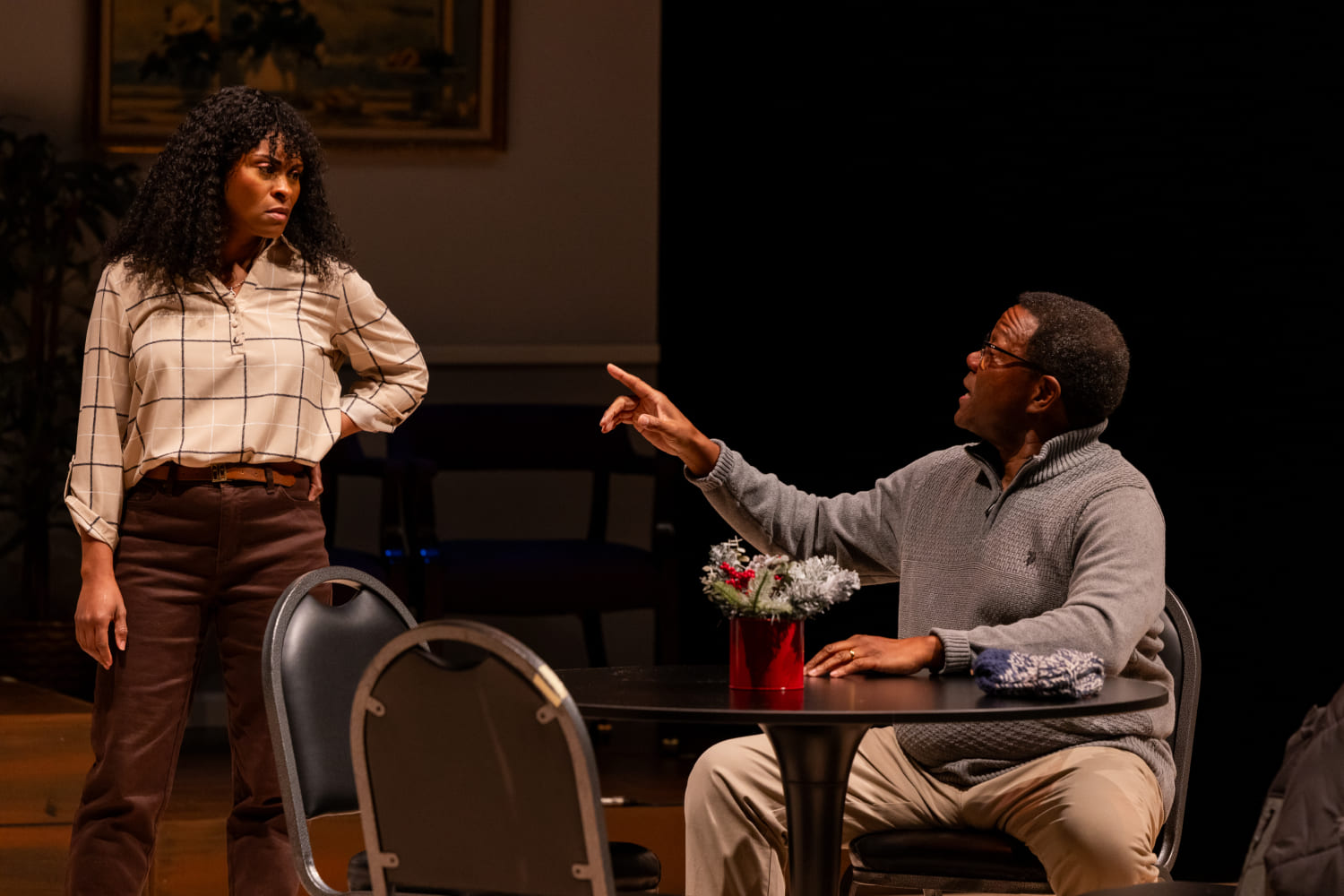
Rita Cole and Robert L. Strain in City Theatre's "Black Santa" by Aaron Mays. (Photo by Morgan Sophia Photography)
Harvey lends teacher Sydney an uneasiness that suggests this bystander doesn't like conflict; she just wants everyone to get along.
Behind the scenes, designer and technical director Jordon Armstrong has created a spacious playing area that encompasses several locations. With appropriate detail, the set suggests an administrator's office, a teacher's lounge, and a classroom. But it is difficult to tell where one location ends and another begins. The set's decorations are appropriate for the holidays, complete with oversized candy canes and icicles hanging from above.
Eric Nelson's lighting is appropriately naturalistic, while Dario Almiron's costumes help us differentiate one character from another. Also, Lucas Doytier's sound design helps to make the performers' words audible and comprehensible.
The playwright, whose parents were teachers in Buffalo, writes impressively naturalistic dialogue. Clearly, he has a sharp sense of humor, and a good ear for how certain people talk. While we could learn a few more details in “Black Santa,” such as the school's demographics, the piece is generally a funny, moving, and engaging play. It should enjoy a long, successful theatrical life.
IF YOU GO
WHAT: “Black Santa” by Aaron Mays
WHERE: Carnival Studio Theater in the Ziff Ballet Opera House at the Adrienne Arsht Center for the Performing Arts. The address is 1300 Biscayne Blvd. in downtown Miami.
WHEN: Through Sunday, Dec. 22. Performances are at 7:30 p.m. Thursday, Friday, and Saturday, as well as 2:30 p.m. Saturday and Sunday
TICKETS: $56 and $61. VIP experience for an additional $30 includes a drink, up-front seating and a gift bag; a portion of the proceeds benefits City Theatre's arts education initiatives.




